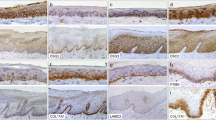Abstract
We have used immunohistochemistry to test the hypothesis that components of the desmosome are disrupted during neoplastic progression of squamous epithelial cells in the uterine cervix. Sections of normal cervix and squamous intraepithelial lesions (SILs) were immunostained for desmosomal proteins and glycoproteins, and results were assessed using a semi-quantitative grading system. No difference between normal cervix and low-grade SIL (LSIL) was found. A significant reduction in expression of desmogleins was seen between high-grade SIL (HSIL) and LSIL (P<0.01) and normal cervix (P<0.001). Desmocollin expression was not reduced significantly, although scores showed significantly greater variation in HSIL compared with LSIL (P<0.05) and normal cervix (P<0.05). There was no significant difference in desmoplakin expression among the three groups. The results suggest that there may be sequential disruption of desmosomal function during neoplastic progression of cervical squamous intraepithelial cells, with downregulation of desmogleins during the progression from LSIL to HSIL and loss of desmocollin expression occurring in some cases of established HSIL.


Similar content being viewed by others
References
Burkhardt AB (1980) Oral cancer and pre-cancer: ultrastructural and immunopathological aspects. G. Fischer, Stuttgart
Coleman N, Greenfield IM, Hare J, Kruger-Gray H, Chain BM, Stanley MA (1993) Characterization and functional analysis of the expression of intercellular adhesion molecule-1 in human papillomavirus-related disease of cervical keratinocytes. Am J Pathol 143:355–367
Conn IG, Vilela MJ, Garrod DR, Crocker J, Wallace DM (1990) Immunohistochemical staining with monoclonal antibody 32–2B to desmosomal glycoprotein 1. Its role in the histological assessment of urothelial carcinomas. Br J Urol 65:176–180
de Boer CJ, van Dorst E, van Krieken H, Jansen-van Rhijn CM, Warnaar SO, Fleuren GJ, Litvinov SV (1999) Changing roles of cadherins and catenins during progression of squamous intraepithelial lesions in the uterine cervix. Am J Pathol 155:505–515
Garrod D, Chidgey M, North A (1996) Desmosomes: differentiation, development, dynamics and disease. Curr Opin Cell Biol 8:670–678
Garrod DR (1995) Desmosomes and cancer. In: Hart I, Hogg N (eds) Cell adhesion and cancer. Cancer Surv 24:97–111
Hiraki A, Shinohara M, Ikebe T, Nakamura S, Kurahara S, Garrod DR (1996) Immunohistochemical staining of desmosomal components in oral squamous cell carcinomas and its association with tumour behaviour. Br J Cancer 73:1491–1497
Kowalczyk AP, Stappenbeck TS, Parry DA, Palka HL, Virata ML, Bornslaeger EA, Nilles LA, Green KJ (1994) Structure and function of desmosomal transmembrane core and plaque molecules. Biophys Chem 50:97–112
Krunic AL, Garrod DR, Madani S, Buchanan MD, Clark RE (1998) Immunohistochemical staining for desmogleins 1 and 2 in keratinocytic neoplasms with squamous phenotype: actinic keratosis, keratoacanthoma and squamous cell carcinoma of the skin. Br J Cancer 77:1275–1279
Moll R, Cowin P, Kapprell HP, Franke WW (1986) Desmosomal proteins: new markers for identification and classification of tumors. Lab Invest 54:4–25
North AJ, Chidgey MA, Clarke JP, Bardsley WG, Garrod DR (1996) Distinct desmocollin isoforms occur in the same desmosomes and show reciprocally graded distributions in bovine nasal epidermis. Proc Natl Acad Sci U S A 93:7701–7705
O'Keefe EJ, Erickson HP, Bennet V (1989) Desmoplakin I and desmoplakin II: purification and characterisation. J. Biol Chem 264:8310–8318
Parrish EP, Steart PV, Garrod DR, Weller RO (1987) Antidesmosomal monoclonal antibody in the diagnosis of intracranial tumours. J Pathol 153:265–273
Vessey CJ, Wilding J, Folarin N, Hirano S, Takeichi M, Soutter P, Stamp GW, Pignatelli M (1995) Altered expression and function of E-cadherin in cervical intraepithelial neoplasia and invasive squamous cell carcinoma. J Pathol 176:151–159
Vilela MJ, Parrish EP, Wright DH, Garrod DR (1987) Monoclonal antibody to desmosomal glycoprotein 1—a new epithelial marker for diagnostic pathology. J Pathol 153:365–375
Wright TC, Kurman RJ (1996) In: Lacey C (ed) Papillomavirus review: current research on papillomaviruses. Leeds Univ. Press, pp 215–225
Author information
Authors and Affiliations
Corresponding author
Rights and permissions
About this article
Cite this article
Alazawi, W.O.F., Morris, L.S., Stanley, M.A. et al. Altered expression of desmosomal components in high-grade squamous intraepithelial lesions of the cervix. Virchows Arch 443, 51–56 (2003). https://doi.org/10.1007/s00428-003-0771-9
Received:
Accepted:
Published:
Issue Date:
DOI: https://doi.org/10.1007/s00428-003-0771-9




